2013.10.28 10:46
atemporality at work?
2002.10.28 17:57
Re: Duchamp says viewer finishes the work of art?
...went to read "The Creative Act" within a copy of the latest reprint of Salt Seller... ...before reading "The Creative Act" (re?)read the text right before it, namely, "Regions which are not ruled by time and space....", text of a television interview of Duchamp by James Johnson Sweeney January 1956 filmed at the Philadelphia Museum of Art. [I was in Philadelphia at the time, but still in my mother's womb, waiting for the last hours before Spring it turned out.] This reading turned out to be completely apropos...
Being now more aware of "Regions which are not ruled by time and space...." I propose Museum Studies 6.1 where visitors to the PMA Duchamp Gallery are encouraged to bring along a copy of the Duchamp/Sweeney interview text and then speak some of the passages while in the Duchamp Gallery, thus somewhat closely reenacting sound waves first produced by Duchamp and/or Sweeney within the same space, yet at a different time, obviously.
The next time I visit the PMA Duchamp Gallery you can be sure I'll reenactingly speak "There is a symmetry in the cracking, the two crackings are symmetrically arranged and there is more, almost an intention there, an extra--a curious intention that I am not responsible for, a ready-made intention, in other words, that I love and respect."
"The reflection of a footnote in a mirror is sometimes a new chapter."
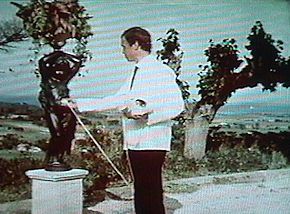
Classic camp interlude: the statue's umbilicus becomes the plug for a telephone cord. Symbolic connection is symbolic communication is symbolic connection.
| |
2003.09.04 18:08
in the thick of reenactment season
Today: I purposefully walked from the front door of the Philadelphia Museum of Art down the Benjamin Franklin Parkway to the far side of Logan Circle and then back to the Art Museum. I did this to get a real sense of the scale of the virtual axis of life within Piranesi's Ichnographia Campus Martius.
In reality I was walking across the forecourt of the Philadelphia Museum of Art, then down the steps that Rocky made famous running up, then across Eakins Oval, where the largest painting in the world once was, then down a tree covered allee along the south side of the Parkway stretching for three long blocks, then around Logan Circle, and then back in the direction I came although this time along the north side of the Parkway.
In virtuality I was walking through the Nympheum Neronis high on the Vatican Hill, through the Porticus Neronis, through the Templum Martis (Temple of Mars), through the Area Martis where the Triumphal Way begins its "march" (this is around where the Rodin Museum is on the Benjamin Franklin Parkway, and, as luck would have it, where the route of many of today's Philadelphia parades begin), then I walked around Hadrian's tomb, and then I walked back.
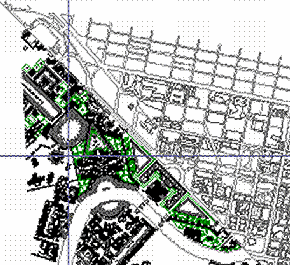
"In fifteen minutes, there'll probably be an APP for that."
| |
2013.11.02 00:37
atemporality at work? from tammuz
it seems that there is a bit more to be said...
in the agamben sense, atemporality catches up with temporality and henceforth, atemporality is synchronized to temporality. instant archiving and the instant rendering of the world into a taxonomy of order. taxonomy is no longer engendered merely to understand the world by; the world now serves as vassal to taxonomy.
yes, i totally understand the sentiment although i think it is also both a depressive and an acquiescent one - the postnecrotic twitchings of a leftism caged in the awareness of its own death. its a postmortem philosophy.
i'm not content with that. its clever but unimaginative - by unimaginitive i mean it accepts to argue within the logic of its enemy...therefore acquiescent. . and your purpose - if i understand from your projects- is to forge connections through the cracks of temporality or rather forge cracks in temporality through discovering or fabricating connections. i don't see that as atemporal; in fact, quite the opposite. i think it disturbs the orthodoxy of archivism and incurs a twist-of-the-head in a new direction, therefore a nudging -even if fictional- away from the world as a self-anesthetized reification (where the process of its own self production infuses the system with an anaesthetic to make it appear inevitable....this is the greatest self defense mechanism for neoliberalism).
so you may be right in that ahistoricity may better describe your domain than atemporality. can one not speak of an ahistorical moment in time? doesn't that also pertain more relevantly to your regard for reenactment. i think agamben's quote is placed diametrically opposite to your direction. perhaps used as a mirror to shatter than to stare in...
2013.11.02 12:44
atemporality at work?
Yes, tammuz, there is indeed still more to be said, and I'm glad to be saying it to you. As I 'discovered' last night, my last post within 'Theory needed: contextualism/transparency' was a reaction to a passage you wrote earlier within the same thread. I used your words (which seem to be critical of work I was presenting) and attached them as labels to more of my work. You, in fact, introduced 'atemporal' into the discussion. [I still want to go over that whole thread to fully understand how things turned there as they did.] Precursive you, too.
Regarding Agamben's 'muse[um]ification,' note how I suggest 'using' the museum then as antidote, thus, yes, "agamben's quote is placed diametrically opposite to [my] direction." Quondam--a virtual museum of architecture has always been an experimental project, e.g., "What can a virtual museum be that a real museum can't be?" Because Quondam's collection is entirely digital, all the data is fluid and pliant, and, as much as the data can render historical taxonomy, it is equally possible to 'use' the data/collection to render ahistorical taxonomy. It is the fluid and pliant [and networked] nature of the data/collection that proffers temproal and/or atemporal taxonomies. Conversely, a museum of architecture comprised of drawings on paper and physical models does not readily offer a fluid and pliant 'use' of the data/collection.
| |

The Driver's Seat real and virtual
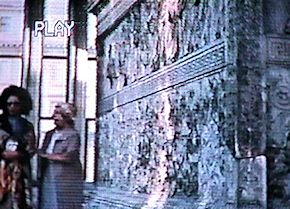
The Driver's Seat at the Altar of Peace
"It's not so much a presence. It's more a lack of absence."
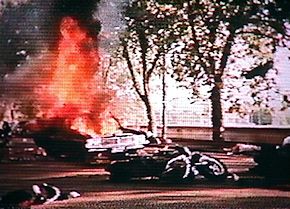
The Driver's Seat terrorist attack in front of the Altar of Peace

The Driver's Seat "What time is it?"
Are cracks being forged in temporality, or are cracks being forged in temporal taxonomy?
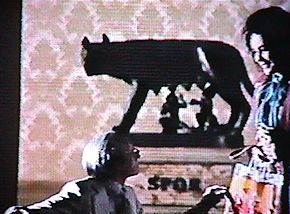
The Driver's Seat (Warhol asks Taylor, "This movie really sucks, doesn't it?")
Is there such a thing as ataxonomy? Is there such a thing as an ataxonomic museum?
| |
2013.11.10 01:11
atemporality at work? from tammuz
quondam,
my mind is pretty lethargic at the moment but here goes...no i wasn't being critical of your work. note that i had conceived of the cut and paste artisan work in terms of economic valorization. i know the sort of professionals i had in mind (and they might be very good and have good intentions). they view architectural history as an ATM, deriving different stylistic currencies depending on the client. a mock versailles for a sheikh, a mock-vernacular persian gulf style for a rich businessman, a mock levantine mountain house-style apartment buildings for a developer, andalusian style for a hotel..etc.
a member of the team was an exceptional philippino architect who was able to take on any style, especially neoclassical ('western') ones and churn out designs that betray a sufficiently astute sensibility when it came to proportion, weight, usage of ornament..etc. he had a lot of experience that he had gained working in offices. he had not undertaken any neoclassically dedicated academic course (i say this somewhat in response to the neoclassical thread running concurrently). but, as gifted as he was, the work could only, disclose its own banality as a product intended to fit a recognizable fantasy. the architect as the Architectural Teller Machine. yes, there was a lot of work behind it, but it was never intellectual. it was largely an exercise in harmonization. intellectually a neoclassicism as outstanding as elevator music.
so no i didn't have your work in mind.
ataxonomy. i am reminded now of peter greenaway's criticism of narratival films, films structured around the linear development of psychological melodrama and how he viewed literature as the true home for such an imagination - not an audiovisual one. thus his films find other structuration devices and orders, other taxonomies than those fettered to the conventional psychological melodrama (character-centric). alphabetic, polychromatic, numerical, calligraphic and above all of course pictorial reliant on the history of painting.
can one say that his work is ataxonomical one? i would definitely disagree. i think in a sense he does/did jar expectations and therefore possibly detaxonimized his work from the psychological point of view (although this is not always true - some of his films are marked by a strong line of narrative and are provided with strong focal psychological character cores). but ultimately, he champions other taxonomies. so, he is highly taxonomical by choice and not by default.
whereas perhaps I don't know understand how you position yourself and the virtual museum on the grand scheme of taxonomy or its lack or subversion thereof. for instance, i did enjoy your analogous building (i think that was the name) . i went to the source buildings and i could read the architectonic associations that you performed , one of which was implicitly allusional (carving out the circular courtyard) and the other was subrogational (replacing part of a building with another building). the composite design turned into a narrative to be read of this very process. in some way, this bestowed upon the source buildings an anonymity of sorts: their identity as integral buildings - as authored designs, completed-had been subverted, the signifying code or insignia of completion had been broken and the building had become an adjunct, something without an identity of its own. and this is interesting and witty. but is there yet another covert narrative? yet another thematic intention encircling this new closure from above? i mean, is there an extra-architectural intention in the hybridization of the three particular buildings?
and, on a yet larger scale, your virtual musuem....the structuration of its entries/exhibits...the lessons that one can derive from them other than the given fluidity of data and its malleability...is there an even larger system at work? i think this will determine the position apropos taxonomy, right?
|